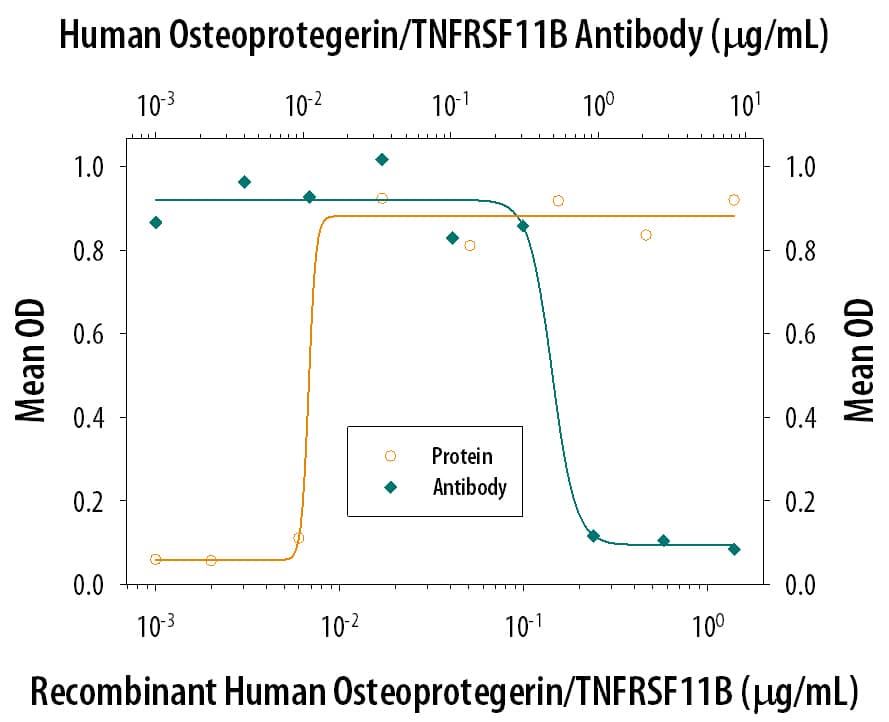Human Osteoprotegerin/TNFRSF11B Antibody
R&D Systems, part of Bio-Techne | Catalog # AF805


Key Product Details
Species Reactivity
Validated:
Cited:
Applications
Validated:
Cited:
Label
Antibody Source
Product Specifications
Immunogen
Glu22-Leu401
Accession # AAB53709
Specificity
Clonality
Host
Isotype
Endotoxin Level
Scientific Data Images for Human Osteoprotegerin/TNFRSF11B Antibody
Osteoprotegerin/TNFRSF11B in Human Lymph Node.
Osteoprotegerin/TNFRSF11B was detected in immersion fixed paraffin-embedded sections of human lymph node using 15 µg/mL Goat Anti-Human Osteoprotegerin/TNFRSF11B Antigen Affinity-purified Polyclonal Antibody (Catalog # AF805) overnight at 4 °C. Tissue was stained with the Anti-Goat HRP-DAB Cell & Tissue Staining Kit (brown; Catalog # CTS008) and counterstained with hematoxylin (blue). View our protocol for Chromogenic IHC Staining of Paraffin-embedded Tissue Sections.Osteoprotegerin/TNFRSF11B in Human Lymph Node.
Osteoprotegerin/TNFRSF11B was detected in immersion fixed paraffin-embedded sections of human lymph node using Goat Anti-Human Osteoprotegerin/TNFRSF11B Antigen Affinity-purified Polyclonal Antibody (Catalog # AF805) at 25 µg/mL overnight at 4 °C. Tissue was stained using the Anti-Goat HRP-DAB Cell & Tissue Staining Kit (brown; Catalog # CTS008) and counterstained with hematoxylin (blue). Specific labeling was localized to the cytoplasm and plasma membrane of lymphocytes. View our protocol for Chromogenic IHC Staining of Paraffin-embedded Tissue Sections.Osteoprotegerin/TNFRSF11B Inhibition of TRAIL/TNFSF10-induced Cytotoxicity and Neutralization by Human Osteoprotegerin/TNFRSF11B Antibody.
In the presence of a cross-linking antibody, Mouse polyHistidine Monoclonal Antibody (Catalog # MAB050) (Catalog # MAB050) and the metabolic inhibitor actinomycin D (1 µg/mL), Recombinant Human Osteoprotegerin/TNF-RSF11B (Catalog # 185-OS) inhibits Recombinant Human TRAIL/TNFSF10 (Catalog # 375-TL) induced cytotoxicity in the L-929 mouse fibroblast cell line in a dose-dependent manner (orange line), as measured by crystal violet staining. Under these conditions, inhibition of Recombinant Human TRAIL/TNFSF10 (20 ng/mL) activity elicited by Recombinant Human Osteoprotegerin/ TNFRSF11B (0.1 µg/mL) is neutralized (green line) by increasing concentrations of Goat Anti-Human Osteoprotegerin/ TNFRSF11B Antigen Affinity-purified Polyclonal Antibody (Catalog # AF805). The ND50 is typically 0.25-0.7 µg/mL.Applications for Human Osteoprotegerin/TNFRSF11B Antibody
Immunohistochemistry
Sample: Immersion fixed paraffin-embedded sections of human lymph node
Western Blot
Sample: Recombinant Human Osteoprotegerin/TNFRSF11B (Catalog # 185-OS)
Neutralization
Reviewed Applications
Read 1 review rated 5 using AF805 in the following applications:
Formulation, Preparation, and Storage
Purification
Reconstitution
Formulation
Shipping
Stability & Storage
- 12 months from date of receipt, -20 to -70 °C as supplied.
- 1 month, 2 to 8 °C under sterile conditions after reconstitution.
- 6 months, -20 to -70 °C under sterile conditions after reconstitution.
Background: Osteoprotegerin/TNFRSF11B
Osteoprotegerin (OPG)/Osteoclastogenesis Inhibitory Factor (OCIF) is a member of the tumor necrosis factor receptor superfamily that lacks any apparent cell‑association motifs and exists as a soluble secreted protein. In the TNF superfamily nomenclature, OPG is referred to as TNFRSF11B. OPG was originally isolated by sequence homology as a TNF receptor family protein during a fetal rat intestine cDNA-sequencing project and subsequently shown to be involved in the regulation of bone density. OCIF was initially purified from the conditioned medium of human embryonic fibroblasts based on its ability to inhibit osteoclast development. Comparison of the amino acid (aa) sequences of human OPG and OCIF proteins revealed their identity. Human OPG/OCIF cDNA encodes a 401 aa residue precursor protein with a 21 aa residue putative signal peptide that is removed to generate the mature soluble protein. The amino-terminal half of OPG contains four cysteine-rich repeats characteristic of TNF receptor family members. The 204 residues of the carboxy-terminal OPG/OCIF was found to contain two death domain homologous regions in tandem. Human and mouse OPG share approximately 84% and 94% amino acid sequence identity, respectively, with the rat OPG. Natural OPG/OCIF has been found to exist predominantly as disulfide-linked dimers. Two TNF superfamily ligands, including the membrane proteins OPG ligand/TRANCE (tumor necrosis factor-related activation-induced cytokine)/ODF (osteoclast differentiation factor)/RANKL (receptor activator of NF kappaB ligand) and TRAIL (TNF-related apoptosis‑inducing ligand)/APO-2 ligand, have been shown to be the cellular ligands for OPG/OCIF. Each of these ligands has been shown to interact with additional TNF receptor family members, including RANK (with TRANCE) and TRAIL receptors 1 - 4 (with TRAIL). The roles of these receptor-ligands in osteoclastogenesis, apoptosis and in the immune system remains to be elucidated.
References
- Lacey, D.L. et al. (1998) Cell 93:165.
- Emery, J.G. et al. (1998) J. Biol. Chem. 273:14363.
- Yasuda, H. et al. (1998) Proc. Natl. Acad. Sci. USA 95:3597.
Alternate Names
Gene Symbol
UniProt
Additional Osteoprotegerin/TNFRSF11B Products
Product Documents for Human Osteoprotegerin/TNFRSF11B Antibody
Product Specific Notices for Human Osteoprotegerin/TNFRSF11B Antibody
For research use only

